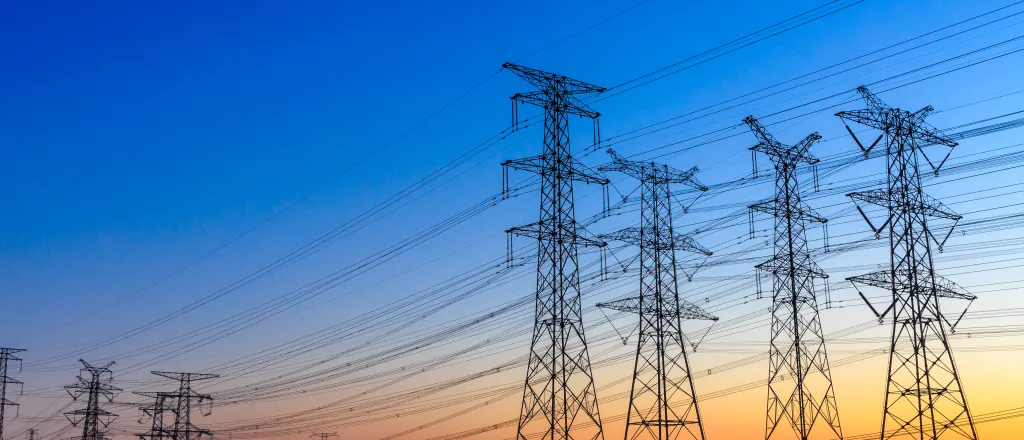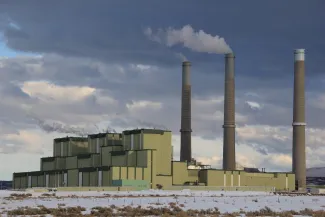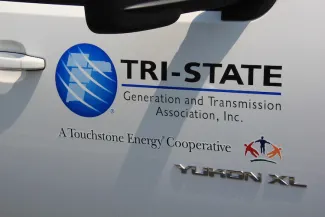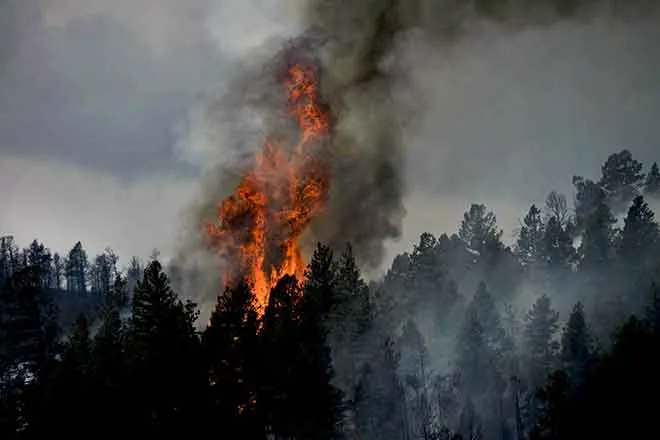
Colorado electrical co-ops lead nation in federal grants
© zhaojiankang - iStock-802436842
(Big Pivots) Three Colorado electrical cooperatives will be getting chunks of a $9.7 billion federal program designed to aid rural America in making the transition to a clean energy economy.
Tri-State Generation and Transmission Association, which delivers power to 41 member cooperatives across four states, 16 of them in Colorado, is in line to get $679 million. That award is in the underwriting stage. Tri-State is confident it will be awarded.
“We are optimistic that our application will move forward and be fully funded,” said Lee Boughey, the vice president for communications at Tri-State.
United Power, an electrical cooperative based in Brighton that has 112,000 members in northern Colorado, expects to get $261 million. Until May, it got all but 5 percent of its electricity from Tri-State.
CORE Electric Cooperative, which is based in Sedalia and serves Castle Rock, Parker and a large swath of land both east and west, also was named a recipient. It was invited to apply for up to $225 million in program budget authority to procure renewable energy sources including wind, solar and batteries through several power purchase agreements, subject to the final funding process.
Colorado was the lone state to have multiple winners. The other 15 recipients span the country from New Jersey and Florida to Arizona and Alaska.

© BigPivots.com / Allen Best
The money comes from a program called New ERA (Empowering Rural America), which was funded through the Inflation Reduction Act passed by Congress in 2022. The program has been called the most important investment in rural America since President Franklin Roosevelt in 1936 signed the Rural Electrification Act. That law provided funding to promote electrification of widely dispersed customers in rural America that investor-owned utilities had found too expensive to serve.
In remarks in Wisconsin on Thursday to celebrate the funding, President Joe Biden also drew comparisons to the legislation that created the interstate highway system in 1956. There,
Dairyland Power Cooperative, which has 24 member cooperatives in Wisconsin and three other states, is to get $473 million from the New ERA program.
Uday Varadarajan, senior principal on the electricity team at RMI, said the New ERA funding will have impacts far larger than the dollar amounts. One key provision of the Inflation Reduction Act allows electrical cooperatives to access money for clean energy that was previously unavailable to them because of their nonprofit status. Tax credits for clean energy development were available to for-profit developers and utilities but not rural cooperatives.
This, Varadarajan said, was a fundamental inequity. It put electrical cooperatives serving rural America at a disadvantage. Now, provisions in the Inflation Reduction Act will level the playing field. “They are now finally able to take advantage of those clean energy tax credits,” he said.
“There are strong reasons to believe that the program over time will increase their financial confidence in really moving more aggressively to take advantage of clean energy, which is increasingly competitive and reliable,” he said.
New ERA funding will allow rural electric co-ops to overcome their reluctance to go into further debt and by reducing the burden of their old debt. With less aversion to taking on new debt, Varadarajan explained, they can feel more confidence about investing in new renewable generation — and owning it instead of mostly buying the generation through power-purchase agreements.
Varadarajan credited Tri-State in making the pivot from being just a big cooperative to now becoming a leading cooperative in aggressively taking advantage of the incentives to move thoughtfully and carefully to transition their system from fossil fuel generation to renewable resources.
And Colorado’s prominence among the recipients also reflects on the state’s political leadership and the grassroots support, he said.
Tri-State lobbied hard for a carve-out in the Inflation Reduction Act that would allow it and other cooperatives that serve predominately rural areas of the United States to get assistance in the energy transition. Based in Westminster, Tri-State had become heavily anchored in coal-fired generation and was weighted down in the transition by the debt on some of these coal plants.

© BigPivots.com / Allen Best
The federal money will be used by Tri-State to support the retirement of 1,100 megawatts of coal-fired generation. It shut down one coal plant in New Mexico in 2019 and has plans to close the three coal-burning units it operates at the Craig Generating Station from 2025 to 2027. It had originally planned to close Springerville 3, a coal plant in Arizona, in 2040, but the promise of the federal funding has given Tri-State the comfort to pay off undepreciated debt in the plant and move up its retirement to 2031. It has made plans not to divest from generation at the Laramie River coal plant in Wyoming.
The award will help Tri-State procure 1,480 megawatts of renewable energy in the form of solar, wind and battery storage. This conversion will reduce member costs an estimated $422 million over 20 years.
The original letter of intent for New ERA funding, submitted by Tri-State a year ago, was for $970 million. Because of the number of applications from across the country, Tri-State and other applicants were advised to moderate their requests. Tri-State was invited to submit a proposal for $679 million.
Through a mix of low-interest loans and grants, Tri-State would look to leverage this budget authority to support investments that could total more than $2 billion for 18 different projects. It plans to issue a request for proposals in September.
In an interview, Duane Highley, the chief executive, said that Tri-State began getting news in early August that it was in line to receive funding. That, along with news from the Federal Energy Regulatory Commission that aligned with Tri-State’s plans, made it his single best week since he joined Tri-State as chief executive in April 2018.
The financial award is also making Tri-State more attractive in the eyes of Wall Street analyst. Highley said Tri-State had been in conversation with Standard & Poor’s and the two other credit agencies. “They are extremely excited,” he said.
The federal money will result in “less risk, a stronger balance sheet and lesser rates” for Tri-State’s members, he said.
Tri-State’s ratings had been declining in recent years as member cooperatives left Tri-State to pursue what they consider to be greener pastures elsewhere. Kit Carson Electric, in New Mexico, left in 2016 and has succeeded greatly. It was followed by Delta-Montrose Electric in Colorado and then, on May 1 this year, United Power. Three others are now in line to leave.
In rural Colorado, the announcement was welcomed by individuals who get power from cooperatives supplied by Tri-State.
“This is a big deal for Coloradans who get their electricity form rural electric coops on Tri-State’s system,” said Jeff Fiedler, a Lake County commissioner who is also a board member of Buena Vista-based Sangre de Cristo Electric Association, a Tri-State member. “Our communities have supported Tri-State’s recent moves to catch up in the energy transition, and make sure we don’t get left behind and miss out on cleaner energy and lower bills for rural residents and businesses.”
From Silverton, Scott Fetchenheier, a commissioner in San Juan County, had said his mountain county — alone among Colorado’s 64 counties with no irrigable acres — is already experiencing the impacts of climate change. “It’s a relief to know this federal funding will give Tri-State the tools it needs to fully transition rural communities off of the coal and gas plants that are fueling the climate crisis. I’m glad to see it,” he said.
“This is such exciting news,” said Jeff Delaney, a resident of Crested Butte. “Rural communities have been looking in from the outside as the country transitions to clean energy, and this funding opens the door for our communities to be able to reap the benefits of the move to renewable energy and leave the harm of fossil fuels in the rear-view mirror.”
Chad Franke, president of Rocky Mountain Farmers Union, called out the plans by Tri-State to spread the projects it plans across its territory, benefitting farmers and ranchers and rural communities across several states.
Also a big winner in this week’s announcement is United Power, which has 113,000 members from the foothills to Colorado’s oil and gas Wattenberg Field. It became independent of Tri-State on May 1 and now generates its own power. The green portfolio of the Brighton-based cooperative currently represents more than 300 megawatts of renewable energy from solar, hydropower and wind.
Another 470 megawatts of solar generation expected to be online will include 160 megawatts from a member’s agrivoltaics project.
Also cited in United Power’s presentation is the cooperative’s Community Benefits Plan, which it says demonstrates investment in a skilled, long-term workforce needed to power the energy transition. This includes an apprenticeship program and line-worker scholarships.
“The New Era funding comes as a direct result of our business model change to a lower carbon future as outlined in Our Cooperative Roadmap three years ago,” said Mark Gabriel, United’s chief executive. “We will continue the critical work necessary to receive the funding in developing our Community Benefit Plan. This money is directly tied to our independence as a distribution cooperative.”
CORE Electric will also get an award that will be used to procure approximately 550 megawatts of new wind and solar renewable energy along with 100 megawatts of energy storage.
The only other Western state to get New ERA funding in this first round of awards is Arizona. Arizona Electric Power Cooperative, which provides electricity to 40 electrical cooperatives and public power districts in Arizona, Nevada, California and New Mexico. Money will be used for investments in 730 megawatts of solar, 2,910 megawatt-hours of battery energy storage, and 70 megawatts of wind.
According to the funding formula, Tri-State and other larger electrical providers were to get 60 percent of the $9.7 billion, with mid-sized cooperatives getting 20 percent and smaller cooperatives the final 20 percent. Several smaller Colorado cooperatives also submitted letters of interest to RUS for New ERA funding. Those recipients have yet to be announced.
Holy Cross Energy, the Glenwood Springs-based electrical cooperative serving the Aspen-Vail-Battlement Mesa area, is not among them. The coop chose not to apply for assistance because it is already far along on its decarbonization path. In May, it achieved 80 percent emissions-free energy and expects to surpass 90 percent sometime early in 2025.
See more stories about Colorado’s energy transition at BigPivots.com
















